

Maria Ragnestam
William Jewsom
courtesy of the artist and KRAFT gallery (Bergen, Norway)
In this conversation between curator and artistic director Maria Ragnestam and artist Erika Stöckel we learn more about how Stöckel builds her large-scale ceramic installations, starting from a theme and using historical photography, cultural preconditions, and shame as her inspiration.
When I make contact with Erika Stöckel it is via a digital link between a kitchen table in Kiruna and her studio in Oslo. Stöckel is in the process of finalising a work for the exhibition she is soon to open at gallery KRAFT in Bergen, Norway. Having followed her artistic career I find it impossible to withstand the temptation to ask her to show me what she is working on. Via a somewhat shaky internet connection an image develops of an installation in several parts with Stöckel’s charismatic ceramics in focus. The objects with their sculptural expression play an important part in this work, displayed against a blue photographic background which many Swedes of my generation associate with the annual photograph of middle-school pupils. There is something that, in captivating fashion, chafes in the relationship between the bold, blue framework and the cool, beige palette, the ceramics’ strange organic forms and the consciously linear placement between the viewer and the work. A naked vulnerability is present in Stöckel’s installation, it gives the impression of a there being a situation that has come to a halt at the moment just before the camera captured the instant as an image.
'The installation is staged to mimic historical photography of pupils at the nomadic schools in Sápmi and it raises questions about the significance of the gaze and its consequences. On what basis are decisions made as to who belongs and who doesn’t? And who has the right to make these decisions? The installation also considers an outsider’s desire for assimilation as well as a national culture that is forced upon one, a force many Indigenous peoples are subjected to. There is a balance between the concept and the presence of the physical craft which largely builds on the relation between the work and the viewer. I wanted to create a spatiality and a theoretical context, and I searched for a long time for a photographic background with this particular shade of blue.'
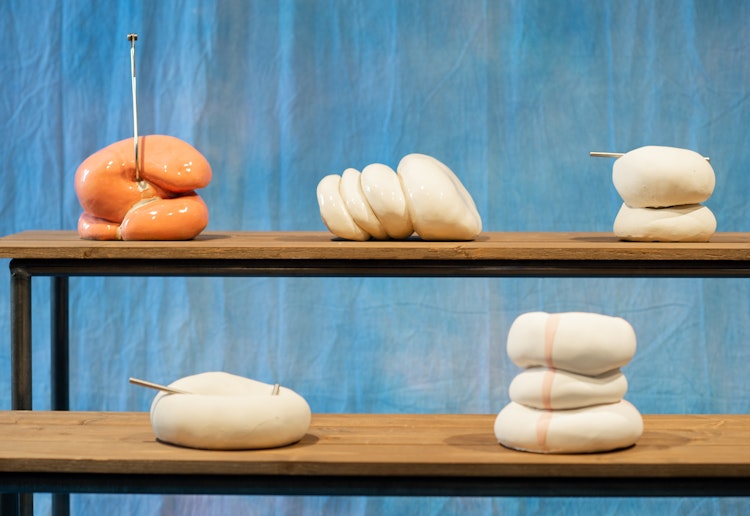
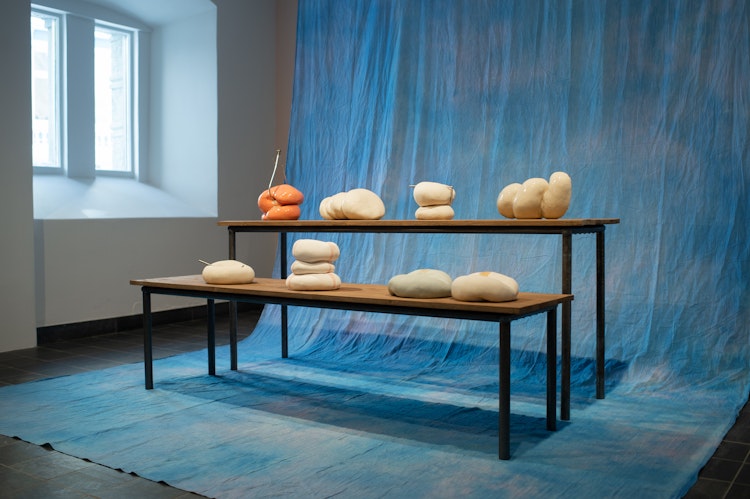
Despite the current public health situation [covid-19], the year has been a productive one for Stöckel who has undertaken an artistic residence in Sweden and has taken part in several exhibitions. Just as the situation with many other artists, scheduled exhibitions and opening dates have been postponed due to the restrictions caused by the current pandemic situation, but this has also given more time for working in the studio. When she received the invitation from KRAFT Stöckel, who is currently taking part with a large-scale installation in the aforementioned exhibition at Sven-Harry’s art museum in Stockholm, chose to produce new works for the exhibition in spite of the very limited time available.
“My process often starts with something concrete and with physical work on the form and goes on to develop from this point of departure. This time it was the concept that was my starting point.”
Regardless of whether the limited time contributed to the process this time appearing to be different, I perceive a new directness in Stöckel’s relation to her art. At times she seems to be searching for words to describe the work we are looking at, but her method of approaching the underlying theme and materiality is characterised by a clear directness. In spite of the fact that Stöckel has not had a traditional training in ceramics, throughout her artistic career she has gotten to know her material well as she frequently returns to it. This is particularly evident in the way she gives form to her sculptures, through precise consideration and care. With an MFA from the Oslo National Academy of Fine Arts in Norway she allows herself space for interpreting her material’s limitations and how these can be dealt with in all aspects of form and context to the ultimate surface layer.
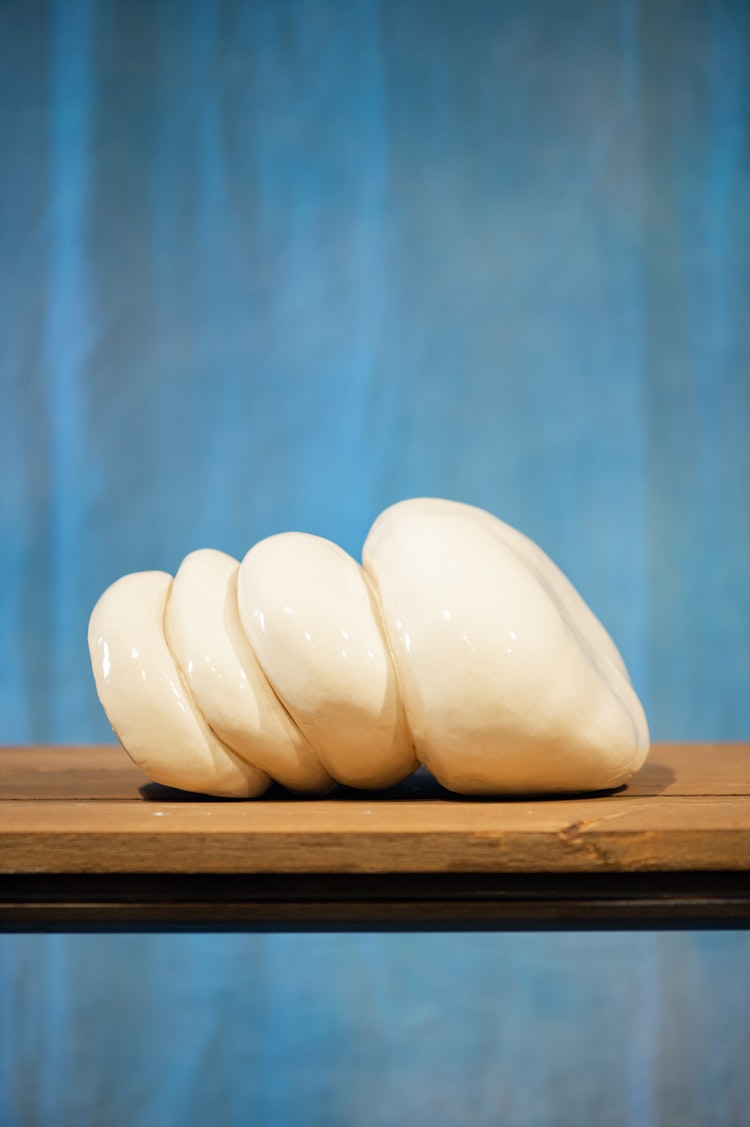
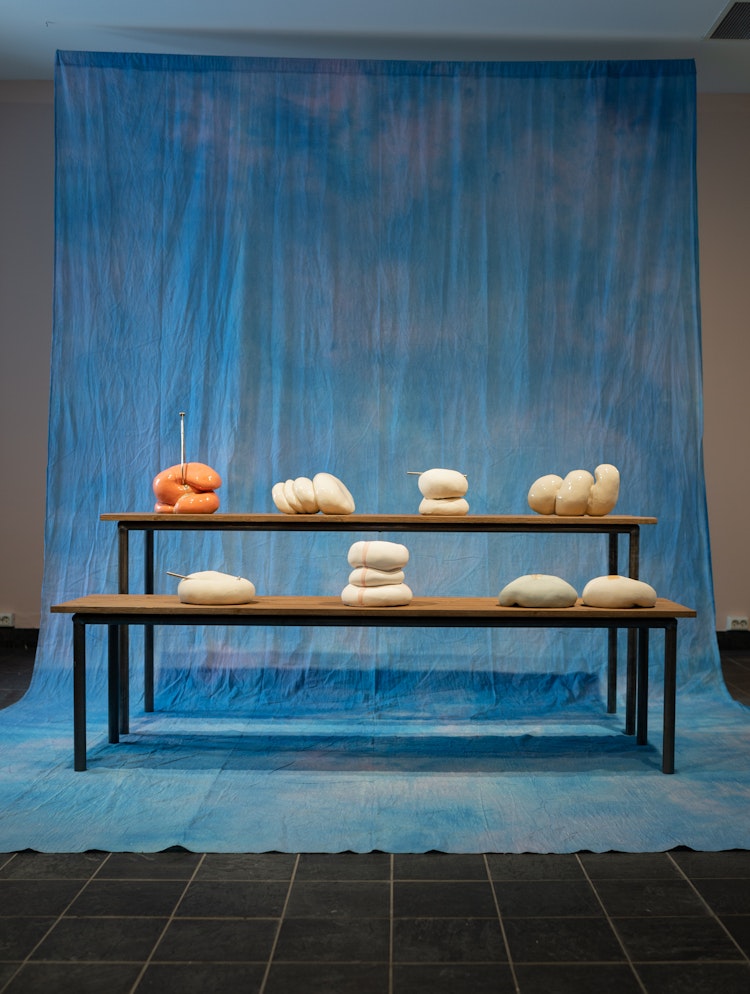
Stöckel’s artistic expression moves within a landscape of familiar forms often consisting of abstracted and expanding parts of the body. In her work she has repeatedly researched the body’s functions and aesthetic. By questioning conventional notions of beauty, she has given power and space to bodies that are normally viewed as non-normative. With a paired down, yet at the same time expansive and corporal approach to form, the details in her works are given a great deal of space. Stöckel’s soft forms pour themselves over each other in a beguiling manner which invites the viewer to come closer. At the same time, she creates her installations in a manner that let the forms slowly continue to take up space beyond the visual presence. For every scrutinising, intrusive gaze the objectification is strengthened, letting the viewer become conscious of her or his own presence and placement in relation to the works.
With a recurring language of form she moves unimpeded between different scales, structures and colours without her work becoming predictable. Clay and glazes can be formed and controlled with real precision, while at the same time the serendipitous aspect is preserved in Stöckel’s work. The challenge represented by working in a material with a will of its own has resulted in a different expression than she had originally planned. And this is something that she uses to her advantage in her carefully constructed installations. A glaze with an unexpected colour or a sculpture that has cracked is not always a reason for being excluded from what is ultimately exhibited. At times such irreparable mistakes have been consciously added to the object in order to contribute to the totality of the work. In her artistic expression there is a resistance towards conformity.
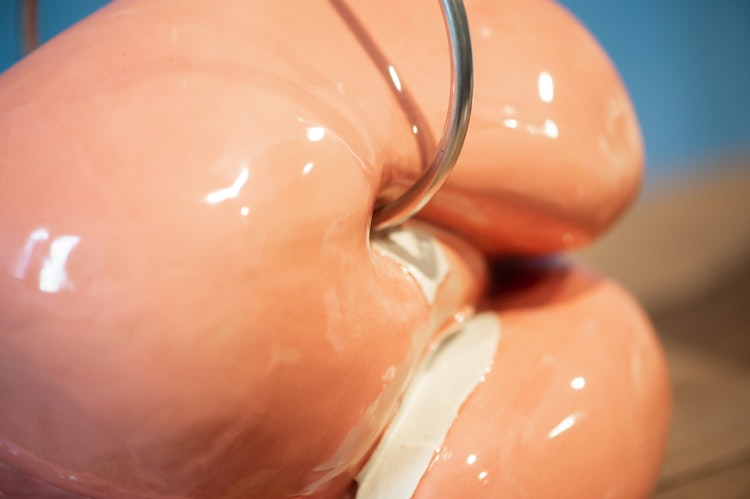
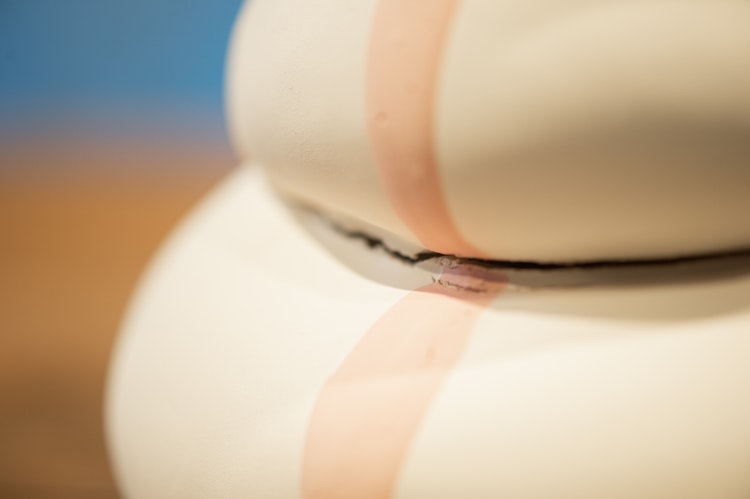
The characteristics of the material, and the possibilities offered, are important to me, but they are not enough
'There is a risk that a sculpture becomes nothing more than a beautiful object. The characteristics of the material, and the possibilities offered, are important to me, but they are not enough. I am not interested in falling into step with what is expected of me but, rather, in investigating how borders can be erased. Expectations regarding my participation as, for example, a craftsperson or a Sámi artist, as well as the viewer’s interpretation of my works, change depending on how the context and the background to my work are presented.'
Context and theme are the specific conditions that Stöckel relates to in her work. By means of her artistic expression she explores how preconceptions and conventional modes of thinking can be challenged, how boundaries can be pushed and how, with the help of her creativity, she can contribute more than expected. Many of Stöckel’s newly created works move as time passes, reminding us of how our own time can, in different ways, relate intimately to historical events. It is only in more recent times that Stöckel’s Sámi background has expressly found a place in her art.
'There is a freedom in art to do whatever I want, but it is also important to me to be truthful in the stories that I tell; that my history and my narrative is mine, and that they start from wherever I find myself, as one of many stories in a complex pluriverse of stories. This is not a strategic choice based on the space that Sámi culture occupies in the artworld today, of working more specifically with how I relate to Sámi culture myself. But nothing happens disconnected from its surroundings, and so naturally the strong Sámi presence has an impact on my work, but there is also plenty of room for, as well as a need for, a different narrative that has yet to be told. I am Sámi but it is only in my adult life that I have worn a Sámi kolt or gákti [Sami traditional clothing]. I do not know the Sámi language and I did not grow up in a reindeer-owning family. It can be hard to determine which parts of my youth have been influenced by my cultural background, the social climate, geographical conditions or my parents’ demands and expectations. My art and my ego are too close to each other. But it is important to me that there should be an entrance through my art to my background that seems interesting to me, and that can also be linked with the society I live in and am a part of.'
Shame is a recurring concept in Stöckel’s work. The inherited sense of shame which often accompanies the loss of a language, of cultural markers and of knowledge. That the place in which one feels at home, where one has grown up, is also the place where the sense of being Sámi is at its lowest, while at the same time not being able, or wishing to reject this part of oneself. In Stöckel’s work there is also a powerful connection with bodily vulnerability both from a historical as well as a contemporary perspective. In her work, the persecuted body has been a recurring theme and an unbending reminder of who is given space. In her work Stöckel has approached the sweaty, female body in the sterile environment of the public baths, and normative structural repression in the wake of Sweden’s eugenics movement and its abusive treatment of Sámi people1, by including notions about power in her artistic practice. Her works balance sensitivity with strength in which both the personal and the collective are investigated.
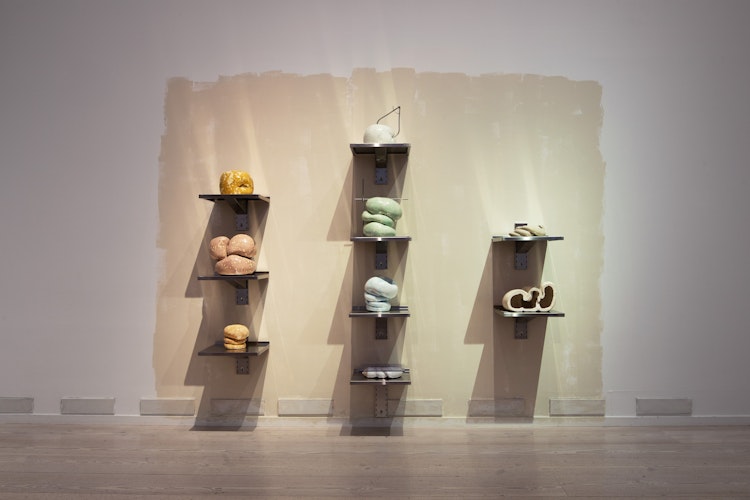
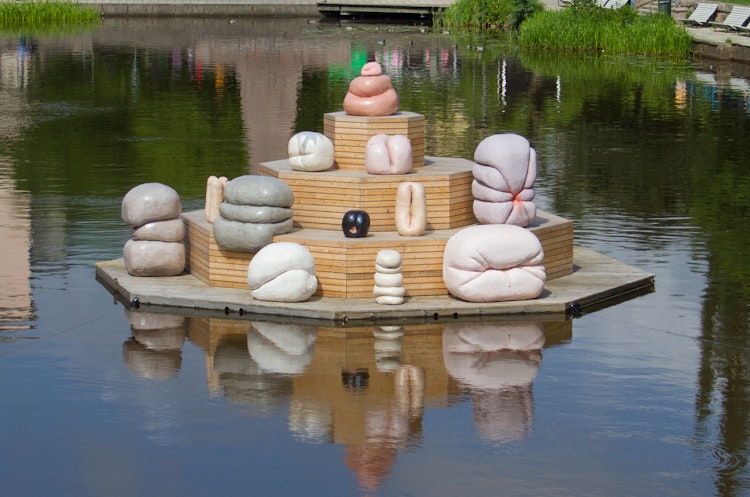
'As an artist it happens that one is drawn in a particular direction and I think that one remains there for as long as there is something to be explored; something that causes resistance or that creates a positive sensation. It would probably have seemed rather dull both for me and the audience if I always had a well-considered plan [for my art], or an expression for the sake of an expression or a content wholly adapted to current social concerns. I believe that one can recognise when artists are working with something that deeply interests them. Though this is not to say that the subject the artist is dealing with has to be a simple or easy-to-understand, or that it needs to be about more than materiality, for that matter.'
During the next two years Stöckel will be one of five artists who will take part in an artist-in-residence programme, Atelier Kunstnerforbundet, in Oslo, where she will continue to have space for ideas, exchanges and production. The programme is also giving her the opportunity to choose one or more artists to act as mentors in her ongoing projects.
'There are some names I am considering. I really want to take the opportunity of gaining new insights into my own artistic expression and of using dialogue that questions things and that can lead to new angles and perspectives.'
I leave our discussion with the same sort of curiosity that it began and with a feeling of excitement for Stöckel’s exhibition Normal behavior, behave normal.